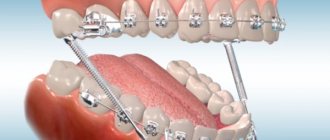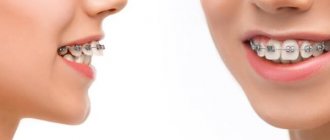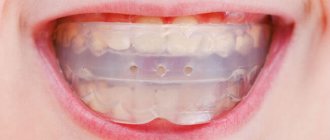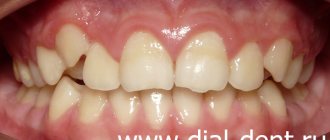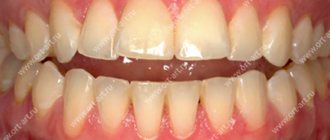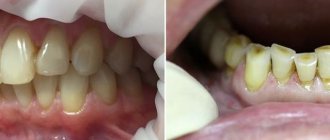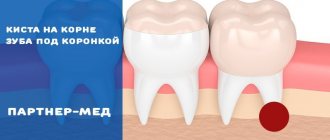Unfortunately, not all dental defects are corrected with the help of braces, mouth guards and aligners. Quite often, patients experience pathologies, the elimination of which requires the use of more radical measures. This occurs in cases where the cause of malocclusion is not individual dental units, but a disproportion in the development of the upper and lower jaws.
A palatal expander is an orthodontic device that is intended to correct abnormalities in the development of the upper jaw.
Design features of the palatal expander
A palatal expander is a metal orthodontic structure that has:
- support rings (crowns) - placed on molars;
- screw - designed to expand the device;
- wire arches - connected to supporting elements and a lock, creating a shock-absorbing effect of the structure.
Due to the constant pressure of the device on the lateral parts of the upper jaw, they quickly stretch.
How is treatment performed with the FAGGA device?
The FAGGA device is fixed to the upper jaw and provides stimulation of the soft tissues of the upper jaw. As a result of activation of the device, an effect occurs on bone structures, and stimulation of soft tissues ensures their regeneration.
On the lower jaw, onlays are made for chewing teeth, which provide freedom of movement of the lower jaw forward and its rotation, which helps relieve compression of the temporomandibular joints. During the treatment process, the lower jaw follows the upper jaw and as a result of treatment, the correct physiological movement of the lower jaw is formed, which is beneficial for the health of the joints.
Commentary by orthodontist O.A. Baranova: “The concept of the work of the orthodontic department of our clinic is such that we work structurally, myofunctionally, and only after that it remains to correct the position of the teeth. Thus, we can call our work exactly TREATMENT, and not just mechanical alignment. Therefore, we almost always use devices that work with the JAWS themselves, and through them, with the help of osteopaths, with other cranial bones, ultimately relieving our patients of many functional complaints, or preventing their occurrence, making the face more symmetrical, beautiful, harmoniously developed. And the FAGGA device is one of those magical assistants that allows us to provide treatment of exactly this level.”
Advantages and disadvantages of a palatal expander
Orthodontic construction has a number of advantages. These include:
- short active treatment period - it takes only a few weeks to correct the pathology;
- the ability to accurately predict the final result;
- expansion of the jaw does not entail a change in the position of the roots of the teeth, but allows them to remain in the same sockets without provoking;
- the design of the product is highly safe - the likelihood of injury to the oral mucosa due to device failure is excluded;
- high aesthetics - the device is invisible to others.
The negative points are the following:
- despite its high aesthetics, the palatal expander is a bulky orthodontic structure;
- the surface of the tongue is subject to a high probability of mechanical damage by the locking mechanism of the product;
- the adaptation period is accompanied by impaired swallowing function;
- presence of excessive salivation;
- pronounced articulatory disorders;
- the active period of treatment is accompanied by painful sensations.
Many patients are consoled by the fact that the discomfort associated with the use of a palatal expander does not have to be endured for long.
Features of orthodontic treatment with the FAGGA device
There are two phases of treatment. The first is the expansion phase of the palate, during which bone growth occurs. The second is treatment with braces to close the gaps between the teeth and create proper interdental contacts. An orthodontist performing treatment with the FAGGA device must have extensive knowledge and experience, and be able to combine various equipment in order to achieve a successful and lasting result of bite correction. Dial-Dent orthodontists are sufficiently qualified to carry out complex treatment and have experience working with various orthodontic equipment.
Indications and contraindications
The only indication for installing a palatal expander is a pathological narrowing of the upper jaw - micrognathia.
It can develop due to:
- genetic conditioning;
- disorders of fetal development in the embryonic period;
- disruption of the endocrine system;
- consequences of rickets;
- disorders of mineral metabolism in the human body.
There are contraindications for using a palatal expander.
These include:
- asymmetrical crossbite;
- open bite of anterior teeth;
- the presence of skeletal jaw asymmetry;
- convex profile;
- inflammatory processes in periodontal tissues.
How the FAGGA device is made
After the orthodontist’s calculations and selection of the FAGGA device for treatment, the patient’s dental system is scanned. The scan result and the orthodontist’s order are sent to the laboratory, where an individual device is manufactured.
Dial-Dent cooperates with a laboratory in Canada. An analysis of various manufacturers has shown that such cooperation guarantees the highest quality and safety for patient health. The laboratory uses the best materials and strictly adheres to technology at all stages of manufacturing the FAGGA device. Transferring scan data and the finished device to Dial-Dent does not take much time, thanks to properly configured logistics and modern digital technologies.
Preparatory stage and installation of a palatal expander
Having examined the patient and drawn up a plan for correcting the pathology, the orthodontist begins preparing the patient for the installation of an orthodontic product.
For this purpose the following is carried out:
- a thorough examination of the patient’s oral cavity and, if necessary, treatment of carious teeth;
- professional hygienic cleaning;
- increasing the distance between the supporting molars using separation rings installed for 7 days.
The palatal expander is installed using two methods:
- directly in the patient’s oral cavity;
- on a plaster model of the patient's jaw.
Support rings can be standard or custom made.
The orthodontic screw is selected by the doctor in accordance with the therapeutic task.
Installation of wire arches is carried out by fixing closed loops with locks of support rings.
Expansion of the lower jaw
A narrow lower jaw, or microgenia, can be corrected in childhood with special devices - distractors. This is a device that gradually stretches the bones of the lower jaw. New bone and soft tissue grows at the site of the sprain. When installing a distractor, first increase the distance between the canines of the lower jaw. Every day the device allows you to increase the lower jaw by 1 mm. When the jaw is wide enough to accommodate tooth growth, the distractor is placed in place for at least two weeks to stabilize the sprain.
If you have a problem similar to that described in this article, be sure to contact our specialists. Don't diagnose yourself!
Why you should call us now:
- We will answer all your questions in 3 minutes
- Free consultation
- The average work experience of doctors is 12 years
- Convenient location of clinics
Single contact phone number: +7
Make an appointment
In adult patients, the lower jaw bones are fused and cannot be stretched, as in children. Therefore, to enlarge the lower jaw, the surgeon cuts the bone in several places with an ultrasonic knife. On the fourth day after surgery, an expansion device is installed. The first adjustment of the stretching is carried out by an orthodontist, then the patient himself controls the stretching process, which can take up to six months.
After expanding the lower jaw, braces are installed on the lower front teeth to correct the bite. Crowded teeth gradually occupy the resulting space.
The photo below shows a narrow jaw before and after expansion.
Oral hygiene when using the device
The presence of any orthodontic structure in the oral cavity requires the patient to pay increased attention to the condition of the teeth and mucous membrane.
To avoid the development of diseases caused by the accumulation and development of pathogenic microbes on the palatal expander and teeth, it is necessary to use the following hygiene products:
- toothbrush and toothpaste (twice a day);
- use of rinse aid;
- removing food debris using toothpicks, floss, brushes;
- The presence of an irrigator will facilitate the care of the orthodontic product.
Changing the size of the jaw is a physiologically and morally very complex process. If it is not possible to avoid it, then strictly follow the orthodontist’s instructions - this will help shorten the active therapeutic period.
How quickly does the upper jaw increase in size with FAGGA?
The FAGGA device allows you to increase the upper jaw by 6–10 mm in an average of 4–6 months. Each patient is unique, and it is very difficult to predict how the body will react to treatment in each specific case, so the orthodontist can give an approximate treatment period.
Commentary by orthodontist M.N. Ostroukhova: “After diagnosis, we can name the approximate terms of treatment, but they depend both on the individual characteristics of the body and on the patient’s compliance with all recommendations. In general, treatment times with this device are quite accurate if the patient visits the orthodontist on time and the activation of the device is not disrupted.”
How are orthognathic surgeries performed?
Any modern orthonic procedure is performed using internal access to the oral cavity. This means that there will be no external cuts, wounds, or scar tissue. The type of anesthesia is also selected in each specific case - it all depends on the type of operation. The average duration of the procedure is from 30 minutes to 5 hours, respectively.
Benefits of jaw surgery:
- “Turnkey” harmonization – the operation allows you to eliminate both functional and aesthetic problems;
- Monitoring the condition after surgery - the doctor monitors the recovery process until the patient is completely satisfied with the result;
- Modern surgical intervention is as gentle as possible, on an outpatient basis, without the need for a long break from work.
Installation process
The Marco Rosa apparatus has four elements that are used to fix it to the jaw. Two rings (left and right) that fit on the molars, and two legs (also left and right) that rest on the fangs.
Installation is performed in the following sequence:
- A week before installing the device, separating rubber bands (separation rings) are inserted between the supporting painter and adjacent teeth, which create a gap for installing metal rings on the painters. On the day of installation of the plates, these elements are removed before the start of the procedure.
- All teeth are cleaned with a rotating brush and toothpaste.
- Prepared cement is applied to the rings of the apparatus.
- The device is inserted into the mouth, the rings are put on the molars and pressed all the way with the instrument. The paws should be located on the occlusal surface of the canines. Excess cement is removed.
- The interdental spaces in the area where the rings are fixed are cleaned with thread.
- A composite is applied to the fangs at the point of their contact with the paws to fix the paws. Excess composite is removed.
- The junction is irradiated with light (to polymerize the composite).
This completes the installation of the plate..
In the video, watch how the Marco Ross apparatus is installed.
All the pros and cons of the technique
The Marco Ross device demonstrates almost one hundred percent successful results due to a number of features:
- High efficiency due to the fact that expansion occurs along the unfused median palatal suture.
- Complexity of impact. Along with the expansion of the jaw, the symmetry and aesthetics of the face are restored, the nasal passages are expanded (nasal breathing becomes easier), speech and swallowing are normalized, and mesial occlusion is eliminated.
- Short wearing period when using rapid expansion.
- Inconspicuous when worn.
- Elimination of treatment with braces or, in extreme cases, its significant relief.
- Easy ability to set the expansion rate (the screw can be turned to a larger or smaller angle, daily or intermittently).
- Possibility of use in primary and mixed dentition , when the correction of any dental anomalies is most effective.
- Simplicity and elegance of the design , bright color of the base plates, attractive to the child (creates motivation and eliminates the baby’s anxiety).
The only disadvantages include discomfort after activation and the need for long-term retention. But these features are characteristic of all orthodontic devices without exception.
General overview
The full name of the Ross apparatus is plate-type, non-removable, mechanically operating, single-jaw. The device consists of the following elements:
- Hyrex screw with guides on both sides. Serves to create an expanding force.
- Rings for temporary molars. Provide fixation of the device on the supporting teeth.
- Metal feet. They rest against temporary fangs, creating points of application of force to the dentition, additional to the rings.
- Plastic base (plate), consisting of two parts. Combines all components into a single design.
The device bears the name of its developer. It is made from a plaster model, molded according to an impression from the child’s upper jaw. Costs about 10,000 rubles.
The use of the device allows you to expand the upper jaw along the median seam by 10-13 mm, increase the length of the upper jaw arch, eliminate mesial occlusion, and achieve normalization of a number of other functions of the dentofacial apparatus in children aged 5-11 years.
Depending on the tasks being solved, the Ross apparatus can be modified, in particular, equipped with dental onlays.
Indications for use
The optimal time to use the device is 6-8 years. However, depending on the clinical picture, this interval can be extended to 5-11 years.
Indications for the use of the Marco Ross apparatus are many pathological changes in the dentofacial apparatus caused by a narrow upper jaw:
- Cross mesial bite.
- Lack of space for permanent teeth in the anterior segment of the upper jaw. Lack of space causes permanent teeth to shift relative to the dental arch, either palatally (usually) or vestibularly, when they erupt.
- Speech impairment due to limited tongue movement.
- Mouth breathing due to narrow nasal passages.
- Excessive development of the lower jaw and its blocking by the upper teeth.
- Problems with biting and chewing food.
- Lack of physiological abrasion of primary canines, preventing correct occlusion.
- TMJ dysfunction due to mesial crossbite. Its signal can be headaches that are otherwise unexplained.
What devices does Nord's device belong to by purpose?
Visit here to view popular preventive orthodontic appliances.
At this address https://orto-info.ru/sistemyi-vyiravnivaniya-zubov/lechebno-profilakticheskie-apparatyi/vse-sekretyi-fnta.html all the most important things about the functional fixed telescopic device.


